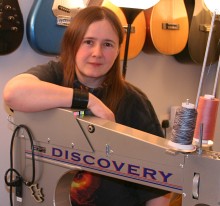 The other use for the image is to translate the strange shapes into a human. It's hard enough to tell what the fabric represents in the photographs, but trust me it is far harder in real life and it is one of the reasons I always take a lot of pictures they help. Once I have worked out what the fabric is trying to show I can try and figure out which way the the quilting lines need to go to improve the image. Fortunately with humans I do at least have a sample on hand. You can feel your own shoulder and feel where the bones are. I've done different styles of quilting on different quilts but for this one I am trying to have the quilting follow the body structure. It's fiddly but it seems to work quite well.
The other use for the image is to translate the strange shapes into a human. It's hard enough to tell what the fabric represents in the photographs, but trust me it is far harder in real life and it is one of the reasons I always take a lot of pictures they help. Once I have worked out what the fabric is trying to show I can try and figure out which way the the quilting lines need to go to improve the image. Fortunately with humans I do at least have a sample on hand. You can feel your own shoulder and feel where the bones are. I've done different styles of quilting on different quilts but for this one I am trying to have the quilting follow the body structure. It's fiddly but it seems to work quite well.The collar bone was fairly easy to deal with and the indentation next to it. The central section of the chest was harder to sort out so I decided to start work on the opposite arm instead. I tend to jump about a lot. When I can see what needs to be done on an areas I do it, and come back to the trickier pieces. Sometimes the tricky bits have vanished in the easy bits which is always nice.

The pins in the quilt are marking transitions to give me some guidelines. Quite often one shade of fabric will span multiple body parts and for this quilt I want the quilting to separate them. I like to use pins for marking as they are easy to remove. I've had enough bad experiences with marking tools I try not to use them at all now. You can see on the arm how I have followed the line of the arm but also the shape of the fabric. I don't want to use the same colour thread on the two areas. If I did the thread would be very visible on one of the fabrics, which could make it too invasive. The thread may also reduce the contrast in the shades of the fabrics. Sometimes that can be helpful, but on the whole I want the best match I can get. On this quilt I had some problems choosing the palest fabric. It wasn't really as pale as I would like, so the thread I used on it is bright white, just to lift it a little.
I applied the same principles for the top of the other arm and quilted a bit more of the background. Mostly the background is keeping pace with the quilting on the image.








1 comment:
Wow.
Post a Comment